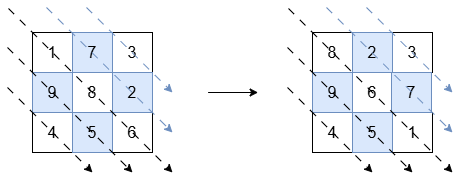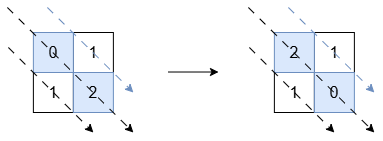LeetCode in Kotlin
3446. Sort Matrix by Diagonals
Medium
You are given an n x n square matrix of integers grid. Return the matrix such that:
- The diagonals in the bottom-left triangle (including the middle diagonal) are sorted in non-increasing order.
- The diagonals in the top-right triangle are sorted in non-decreasing order.
Example 1:
Input: grid = [[1,7,3],[9,8,2],[4,5,6]]
Output: [[8,2,3],[9,6,7],[4,5,1]]
Explanation:

The diagonals with a black arrow (bottom-left triangle) should be sorted in non-increasing order:
[1, 8, 6]becomes[8, 6, 1].[9, 5]and[4]remain unchanged.
The diagonals with a blue arrow (top-right triangle) should be sorted in non-decreasing order:
[7, 2]becomes[2, 7].[3]remains unchanged.
Example 2:
Input: grid = [[0,1],[1,2]]
Output: [[2,1],[1,0]]
Explanation:

The diagonals with a black arrow must be non-increasing, so [0, 2] is changed to [2, 0]. The other diagonals are already in the correct order.
Example 3:
Input: grid = [[1]]
Output: [[1]]
Explanation:
Diagonals with exactly one element are already in order, so no changes are needed.
Constraints:
grid.length == grid[i].length == n1 <= n <= 10-105 <= grid[i][j] <= 105
Solution
class Solution {
fun sortMatrix(grid: Array<IntArray>): Array<IntArray> {
val top = 0
var left = 0
var right = grid[0].size - 1
while (top < right) {
var x = grid[0].size - 1 - left
val arr = IntArray(left + 1)
for (i in top..left) {
arr[i] = grid[i][x++]
}
arr.sort()
x = grid[0].size - 1 - left
for (i in top..left) {
grid[i][x++] = arr[i]
}
left++
right--
}
var bottom = grid.size - 1
var x = 0
while (top <= bottom) {
val arr = IntArray(bottom + 1)
for (i in arr.indices) {
arr[i] = grid[x + i][i]
}
arr.sort()
for (i in arr.indices) {
grid[x + i][i] = arr[arr.size - 1 - i]
}
bottom--
x++
}
return grid
}
}

